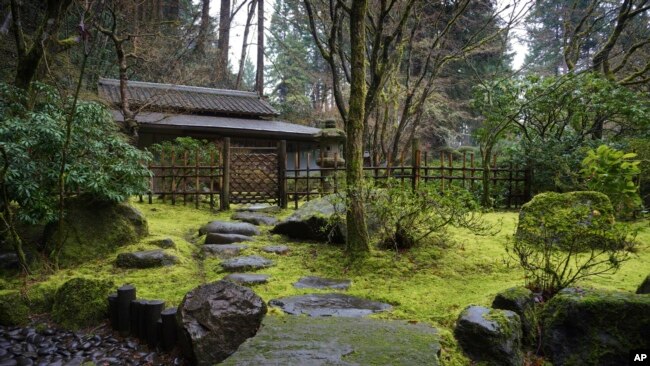雪見障子から眺める切り取られた風景、
日本庭園に面した美術館からの窓枠に収まる絵画のような景観、
丸窓から色付いた楓などが見える風情。
どれも息を飲む美しさがあります。
我が家はマンション住まい故、なんとも殺伐としていますが、最近ベランダ大改造をしました。和風庭園にはできませんが、それでも部屋からの眺めを考慮した花や木々の配置、人工芝に木のフェンス、植木鉢も和風にしてランタンも置いて。夜空を見ながら眺める揺れる灯りが心を和ませてくれます。
さぁ、VOAが伝える日本庭園の魅力とは!
英語力を磨いて再発見しましょう!
Here we go!!
日本庭園 は屋内外の空間をつなぐ(和訳)
Japanese Gardens Bridge Indoor, Outdoor Space
日本庭園がアメリカで初めて注目されたのは、1893年のシカゴ万国博覧会でした。
それから120年以上が経過した現在でも、日本庭園はアメリカのガーデンデザインの中で重要な位置を占めています。北米日本庭園協会によると、現在、アメリカ国内には200以上の日本式パブリックガーデンがあるといいます。
日本式庭園は、屋内と屋外の空間を結びつけるものだと、ニュージャージー州のアッシャー・ブラウン氏は言います。ニュージャージー州のアッシャー・ブラウンさんは、アメリカの人々のために日本的な庭園を作っています。彼は日本の京都で修行しました。
「日本で庭が成功している理由の一つは、家と庭の関係が非常に一体化していることです」とブラウンさんは言います。さらに、庭は家を囲むように配置されているため、「まるで生活空間がずっと広がっているかのようです」と語っています。
アメリカの日本庭園のデザインは、提灯と呼ばれる特別な照明や、輸入された日本の桜やカエデなど、一般的に知られている特徴を超えてきていると、内山貞文氏は言います。彼はオレゴン州ポートランドの日本庭園を監修しています。彼は南日本から来た3代目の庭師です。
アメリカの日本庭園は、時が経つにつれ、より本物に近いものへと変化していきました。これは、日本庭園に関する本が広く出回ったことが一因だと内山は言います。
ブラウン氏は、日本では庭の空間は室内の空間とつながっているといいます。日本では、庭は室内と連動していて、家から外を眺めたときに、まるで絵画のように見えるものです。
”自然の美しさを日常生活に取り入れるという考え方”は、日本では重要な考え方だといいます。また、日本の庭師は岩や石の美しさに特に注意を払っていると指摘しています。
ジョン・パウエルさんは、テキサス州ウェザーフォード出身のガーデンビルダーで、日本でも研修を受けました。日本の庭に魅力を感じるのは、屋内と屋外の空間が強く結びついているからだと言います。
パウエル氏によると、アメリカでは伝統的に屋外の造園と室内の空間が”非常に切り離されていた”そうです。しかし今日では、"屋内と屋外をつなぐ "というアイデアを好むアメリカ人が増えていると言います。
近年、アメリカの日本庭園にも変化が見られます。以前は日本原産の樹木や植物が多かったのですが、現在はその土地の環境に合った植物を使うことを目指しています。
「全ての植物が日本原産であっても、素晴らしい日本庭園を作ることは可能です」とブラウン氏は言います。
日本庭園の専門家であるガーデンデザイナーによると、よくある誤解として、この種の庭園にはそれほど手間がかからないというものがあるそうです。しかし、日本庭園は他の庭園よりも手間がかかる場合があると言います。
内山さんは、日本庭園には”小さな行動の積み重ね”が必要だと言います。
彼は、日本では、居住可能な土地は全体の20%しかないと述べています。「そのため、人々は自分の環境を大切にすることを学ぶのです。」と。その方法のひとつが、庭の手入れを頻繁に行うことなのです。
Japanese Gardens Bridge Indoor, Outdoor Space (原文)
Japanese-style gardens first gained attention in the United States at the 1893 world exposition in Chicago, Illinois.
Over 120 years later, they continue to be a great part of American garden design. Today, there are more than 200 Japanese-style public gardens in the country, the North American Japanese Garden Association reports.
Japanese-style gardens bring together indoor and outdoor spaces, says Asher Browne of New Jersey. He creates Japanese-like gardens for people in the United States. He did his training in Kyoto, Japan.
“One reason that gardens are so successful in Japan is that the house-garden relationship is set up to be so integrated,” Browne said. He added that gardens surround the house, “so it’s as if your living space extends out much further,” he said.
Japanese garden design in the U.S. has moved beyond the commonly known features such as special lights, called lanterns, and imported Japanese cherry and maple trees, says Sadafumi Uchiyama. He oversees a Japanese garden in Portland, Oregon. He is a third-generation gardener from southern Japan.
Over time, Japanese gardens in the U.S. changed to look more authentic. This happened in part because of more widely available books on the subject, Uchiyama said.
Browne said that, in Japan, garden spaces are linked with indoor spaces. Wherever a person looks out from their home, a garden should look almost like a painting.
He said the “idea of bringing the beauty of nature into daily lives” is an important idea in Japan. He notes that gardeners in Japan pay special attention to the beauty of rocks and stones.
John Powell is a garden builder from Weatherford, Texas, who also received training in Japan. He said Japanese gardens appeal to him because of their strong connection between indoor and outdoor space.
He said that traditionally, outdoor landscaping in the United States “was very disconnected” from indoor spaces. But today, he said, more Americans like the idea of “connecting the indoors and the outdoors.”
There have been changes among Japanese-style gardens in the U.S. in recent years. In the past, the trees and plants chosen were often native to Japan. But today, the aim is to use plants that grow well in local environments.
“It’s very possible to create a wonderful Japanese garden using all native plants,” Browne said.
Garden designers who are experts in Japanese-style gardens say one common misunderstanding is that this kind of garden does not require much work. But they note that Japanese gardens sometimes involve even more work than other kinds of gardens.
Uchiyama said these gardens require “constant small actions.”
He noted that only 20 percent of land in Japan is livable. “So, people learn to care for their environment,” he said. One way they do that is by caring for their gardens often.
Words in This Story
garden - n. an area of ground where plants (such as flowers or vegetables) are grown
exposition - n. a public show or exhibition
integrate - v. to combine (two or more things) to form or create something
feature - n. an interesting or important part, quality, ability, etc.
authentic - adj. real or genuine : not copied or false
landscaping - n. the process of making changes to improve the appearance of (an area of land)
constant - adj. happening all the time or very often over a period of time
